Abstract
Novel (80Li2S − 20AlI3)·yLiI composite solid electrolytes (y = 5, 10, 15) were prepared by mechannochemical synthesis. XRD results showed that the pattern of 80Li2S − 20AlI3 was similar to that of AlI3, which means that Li2S was dissolved in AlI3 matrix during preparation. This structure was still maintained after LiI addition. The current measured at constant applied DC voltage indicated that (80Li2S − 20AlI3)·yLiI composites are intrinsically pure Li-ion conductors. The ionic conductivity at 25 °C of y = 10 was about 2.3 × 10−4 Scm−1, which was about three times higher than that of y = 0. The conductivity of y = 10 increased 20 times to 2.2 × 10−3 Scm−1 at 70 °C. These values were highest among those observed from Li2S-based materials. It was revealed that Li-ion moves in 80Li2S − 20AlI3 by a hoping mechanism, while the lattice dipoles are the origin of Li-ion movement in (80Li2S − 20AlI3)·yLiI. The polarization measurements using Liǀ90 (80Li2S − 20AlI3)·10LiI ǀLi and LiǀLi6PS5Clǀ90 (80Li2S − 20AlI3)·10LiIǀLi6PS5ClǀLi cells proved that 90 (80Li2S − 20AlI3)·10LiI reacts with Li metal, but it is relatively stable at a low voltage. Sample y = 10 was also employed as a solid electrolyte in the positive electrode of a solid-state Li-S battery to study its stability in the voltage range of the positive electrode. CuS and Li4.4Si were the electrode-active materials. The cell was cycled in CC-CV mode at 1.0 mA cm−2 (CC) with a cut-off voltage of 1.0–2.3 V. The cell delivered a stable capacity of about 400 mAh g−1CuS after 40 cycles.
1. Introduction
Sulfide-based solid electrolytes (SEs) are one of the candidates for all-solid-state (ASS) Li-ion batteries due to their high ionic conductivity at room temperature and suitable mechanical properties [1,2,3]. Li7P3S11, Li10GeP2S12, and Li5.5PS4.5Cl1.5 exhibited ionic conductivity higher than 10−2 Scm−1 at 25 °C [4,5,6]. Sulfide-based solid electrolytes can be prepared using different methods: solid-state reaction at high temperature, mechano-synthesis, and liquid phase synthesis [7,8,9]. Until now, most of the reported sulfide-based solid electrolytes have belonged to Li2S-P2S5-LiX (X = halogen) groups; therefore, the search for sulfide-based electrolytes that do not contain P2S5 is an interesting research direction.
The glass and glass-ceramic electrolytes of the (100 − x)Li2S-xAl2S3 group were synthesized using planetary ball milling and thoroughly studied [10]. Amorphous 60Li2S·40AlS1.5 was obtained with a milling speed of 230 rpm, while glass-ceramic containing Li5AlS4 crystal was directly obtained with a milling speed of 510 rpm for 2 h. The highest conductivity of 3.4 × 10−5 Scm−1 at 25 °C was obtained for the 60Li2S·40AlS1.5 amorphous electrolytes. Li2S-SiS2 and Li3PO4-Li2S-SiS2 glassy SEs were also prepared by the melt-quenching method, and their ionic conductivities and electrochemical properties were investigated [11,12]. The highest conductivity, of about 7.6 × 10−4 Scm−1 at 25 °C, was obtained in those systems. The solid-state cell using graphite as active material and 0.03Li3PO4-0.58Li2S-0.39SiS2 as solid electrolyte showed good cycle performance. On the other hand, Li2S-SiS2 amorphous materials were also prepared by mechanochemical synthesis and showed the highest conductivity of about 3.4 × 10−4 Scm−1 at 25 °C [13].
Li2S has been intensively used as positive electrode material in the Li-S battery because its usage enables the employment of graphite or silicon in the negative electrode. However, Li2S is a natural insulator to both electrons and ions; much effort has been made to increase the electron and ionic conductivity of Li2S. Fabricating composites with carbonaceous materials, such as graphene, carbon nanotubes, or carbon nanofibers, will increase the electronic conductivity of Li2S [14,15,16,17]. On the other hand, many other methods for increasing the ionic conductivity of Li2S have been reported so far. Composite nanoparticles with Li2S as the core and Li3PS4 as the shell exhibit ionic conductivity of about 10−7 Scm−1 at 25 °C, which is 104 times higher than that of Li2S nanoparticles [18]. The ionic conductivity of Li2S- Li3PS4 reaches 10−4 Scm−1 at 25 °C in another report [19]. The ionic conductivity of Li2S-LiX solid solution (X = halogen) is about 10−6 Scm−1, which is about 102 times higher than that of Li2S [20]. Solid solutions of Li2S and multivalence cation sulfides, Li2-2xMgxS (0.05 ≤ x ≤ 0.2) and Li2-3xAlxS (0 ≤ x ≤ 0.1667), also show improved ionic conductivity compared with Li2S [21,22]. The ionic conductivity of 80Li2S·20AlI3 even reaches 6.0 × 10−5 Scm−1 at 25 °C [23]. In the same study, 99.5Li2S·0.5AlI3 acted as both SE and active material in an all-solid-state battery. In addition, antiperovskite-like type Li3SI had an ionic conductivity of 2.2 × 10−5 Scm−1 at 25 °C and was employed as SE in the ASS Li-ion battery [24]. It should be noted that the application of Li2S-based as SE in the ASS battery is very rare due to its low ionic conductivity.
In this study, a series of (100 − x)Li2S-xAlI3 and (80Li2S − 20AlI3)·yLiI composite solid electrolytes (y = 5, 10, 15) were prepared by mechanochemical synthesis and investigated using XRD and AC impedance spectroscopy. The ionic conductivity at 25 °C (80Li2S − 20AlI3)·yLiI (y = 5, 10, 15) is higher than that of 80Li2S·20AlI3 and Li3SI because LiI addition reduces the resistance at the grain boundary and interface; to the best of our knowledge, such effects of LiI have not been reported before. Among them, sample (80Li2S − 20AlI3)·10LiI has the highest ionic conductivity, which is about 2.3 × 10−4 Scm−1 at 25 °C. In addition, the complex conductivity suggested the formation of a composite consisting of 80Li2S − 20AlI3 and LiI rather than a solid solution due to the existence of two slopes in the low-frequency region. The use of complex conductivity to differentiate solid solutions from composites has also not been noted before. The electronic conductivity of (80Li2S − 20AlI3)·10LiI is about 1.1 × 10−8 Scm−1; therefore, (80Li2S − 20AlI3)·10LiI is a pure Li-ion conductor. The solid-state cell, which employs CuS as active material and (80Li2S − 20AlI3)·10LiI as solid electrolyte, delivers a stable capacity after 40 cycles.
2. Experimental
Li2S (99.9%), LiCl (99.9%), AlI3 (99.9%), Si (99.99%), Li metal (99.99%), CuS (99.9%), and LiI (99.9%) were purchased from Sigma. P2S5 (99%) was purchased from Merck Group. All chemicals were used without purification.
(100 − x)Li2S-xAlI3 and (80Li2S − 20AlI3)·yLiI composite solid electrolytes (y = 5, 10, 15) were prepared via planetary ball milling using the same conditions as reported previously [23]. For a typical batch, Li2S, AlI3, and LiI were manually mixed for 10 min prior to introduction into 45 mL zirconia pots with zirconia balls (10 mm, 15 balls). The pots were then rotated at 500 rpm for 12 h using a Pulverisette 7 (Fritsch). The obtained samples were recovered and used without any further heat treatment. Li4.4Si was prepared using the procedure reported by Tamori et al. [25]. A total of 0.7814 g Li and 0.7186 g Si (Li:Si = 4.4:1.0 mole ratio) was manually mixed using an agate mortar for about 15 min; the obtained mixture was then introduced into 45 mL zirconia pots with zirconia balls (4 mm, 10 balls). The pots were then rotated at 200 rpm. For one cycle, 10 min milling time and 5 min resting time was employed to avoid the sample from temperature increasing. Li4.4Si was recovered after 50 h of milling time. Li6PS5Cl was prepared using the same method. In a typical batch, 2 g of Li2S, P2S5, and LiCl with a stoichiometric ratio of 5:1:2 was employed. The raw materials were manually mixed for 10 min prior to introduction into 45 mL zirconia pots with zirconia balls (10 mm, 10 balls). A rotation speed of 600 rpm and a rotation time of 20 h were employed.
XRD patterns were recorded using Bruker X8 with a CuKα radiation. The samples were covered with amorphous Kapton film because of their hygroscopic properties.
The total resistivity of the prepared samples was investigated using AC impedance spectroscopy, as reported previously [26]. DC conduction was recorded using stainless steel (SUS) rods as blocking electrodes and lithium metal sheets as non-blocking electrodes. Prior to the measurements, the sample (80Li2S − 20AlI3)·10LiI was made into pellets of about 10 mm in diameter (550 MPa, at RT). Since the sample (80Li2S − 20AlI3)·10LiI continuously reacts with Li metal, a thin layer of Li6PS5Cl solid electrolyte was introduced to the cell to prevent (80Li2S − 20AlI3)·10LiI from direct contact with Li metal. Two SUS rods were employed as current collectors. The currents were measured using a potentiostat (PGSTAT302N, Autolab, Herisau, Switzerland) with applied voltages of 0.2–0.7 V (DC) for 60 min.
DC polarization curves were recorded using the cell LiǀLi6PS5Clǀ(80Li2S − 20AlI3)·10LiIǀLi6PS5ClǀLi cycling at ±0.05, ±0.1, and ±0.2 mA cm−1 [27].
Two-step planetary ball milling was used to prepare the composite cathode. In total, 0.3 g of CuS and Ketjen Black (weight ratio of 4:1) were mixed in zirconia pots using 30 g of zirconia balls (4 mm) at 410 rpm for 10 h. Then, 0.2 g of (80Li2S − 20AlI3)·10LiI was added, and the positive electrode composites were obtained after 2 h mixing at 300 rpm. The ASS Li-S cell was constructed as previously reported using the prepared electrode composite, Li6PS5Cl, and Li4.4Si [26]. The cells were cycles using either CC or CC-CV mode to study the stability of (80Li2S − 20AlI3)·10LiI at a high voltage range. The current density was 0.25 mA cm−2.
All the experiments were carried out in a glove box (Ar-filled, [H2O] < 0.1 ppm) or an airtight sample holder.
3. Results and Discussion
Figure 1 shows the XRD patterns of (100 − x)Li2S-xAlI3 (Figure 1a) and (80Li2S − 20AlI3)·yLiI (Figure 1b) composite solid electrolytes (y = 5, 10, 15). Sample Li2S (x = 0) was characterized by four intense peaks located at 2θ ≈ 27.03, 31.22, 44.77, and 53.15°. The pattern of AlI3 (x = 100) has two intense peaks at 2θ ≈ 25.24 and 29.06°. Samples x = 7 and x = 10 exhibited characteristic peaks of both Li2S and AlI3; however, the features of AlI3 were more clearly observed in sample x = 10 than in sample x = 7. The features of Li2S disappeared in the samples x = 20, 25, and 30, indicating that Li2S became amorphous or a new crystal structure was formed because the XRD pattern of those samples did not completely cover AlI3 peaks. It was also proved that samples 5 ≥ x ≥ 0 exhibited the crystal structure of Li2S [23]. Therefore, (100 − x)Li2S-xAlI3 exhibits the structure of Li2S when 5 ≥ x ≥ 0 and the structure of AlI3 when x ≥ 20; those results also show that the (100 − x)Li2S-xAlI3 solid solution can be prepared by mechanochemical synthesis, and its structure depends on the Li2S mass fraction. XRD patterns of (80Li2S − 20AlI3)·yLiI composites and raw materials are illustrated in Figure 1b. The (80Li2S − 20AlI3)·yLiI composites exhibited the characteristic peaks of AlI3 and no trace of LiI (y = 100) was detected. However, fitting the pattern of sample y = 15 disclosed that the peak at 25.4° is composed of two peaks at 25.4 and 25.9°, and the peak at 29.4° is composed of two peaks at 29.4 and 30.2° (Figure 1c,d). Those fitting results proved that LiI crystal still remained in sample y = 15, while its existence in y = 5 and 10 was not detected. Therefore, LiI might form a solid solution with 80Li2S − 20AlI3 or it exists in the amorphous form in samples y = 5 and 10.
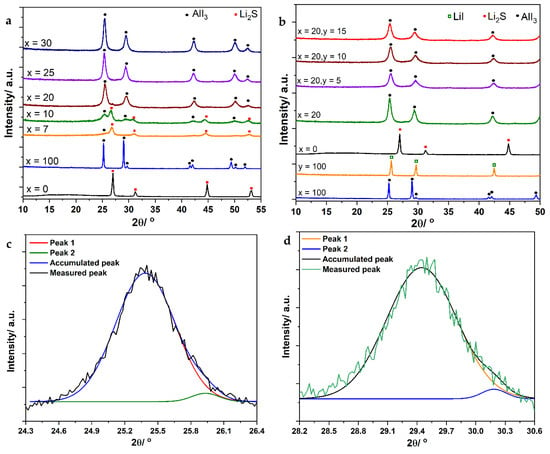
Figure 1.
XRD patterns of the prepared samples. (a) XRD patterns of (100 − x)Li2S-xAlI3; (b) XRD patterns of (80Li2S − 20AlI3)·yLiI (y = 0, 5, 10, 15); (c,d) Fitting result of peak at 25.4° and 29.4° of sample y = 15, respectively.
Figure 2 shows the temperature dependence of the ionic conductivity of (100 − x)Li2S-xAlI3 (Figure 2a) and (80Li2S − 20AlI3)·yLiI (Figure 2b) composite solid electrolytes (y = 5, 10, 15). The small insets show the activation energy of the samples. The ionic conductivity of Li2S at 25 °C was about 10−12 Scm−1 [18,23]. Sample x = 7 exhibited ionic conductivity at 25 °C of about 2.8 × 10−5 Scm−1. Samples x = 20, 25, and 20 had ionic conductivity at 25 °C of about 5.8 × 10−5 Scm−1, 3.8 × 10−5 Scm−1, and 3.1 × 10−5 Scm−1, respectively. The activation energy of sample x = 5, 7, 20, 25, and 30 was about 56, 44, 38, 37, and 60 kJ mol−1. The activation energy of the samples decreased when x increased and reached the minima values of about 38 kJ mol−1 in samples x = 20, 25. Thus, forming a solid solution with AlI3 could enhance the ionic conductivity of Li2S, but the ionic conductivity of (100 − x)Li2S-xAlI3 at 25 °C was still lower than 10−4 Scm−1. It was reported that the ionic conductivity of Li3PS4 improved with LiI addition, so LiI was also added to 80Li2S − 20AlI3 to investigate the ionic conductivity improvement [28,29]. The temperature dependence of the ionic conductivity of (80Li2S − 20AlI3)·yLiI composite solid electrolytes (y = 0, 5, 10, 15) are shown in Figure 2b. The conductivity of 80Li2S − 20AlI3 (x = 20, y = 0) at 25 °C was about 5.8 × 10−5 Scm−1; this value increased to 1.1 × 10−4, 2.3 × 10−4, and 1.0 × 10−4 Scm−1. The activation energy for the Li-ion movement was about 38, 40, 42, and 42 in samples y = 0, 5, 10, and 15, respectively. The existence of LiI crystals, as shown in Figure 1c,d, is responsible for the decrease in conductivity of sample y = 15 compared with sample y = 10. Thus, LiI addition could enhance the ionic conductivity of 80Li2S − 20AlI3 and (80Li2S − 20AlI3)·10LiI had the highest Li-ion conductivity among the prepared sample at 25 °C.
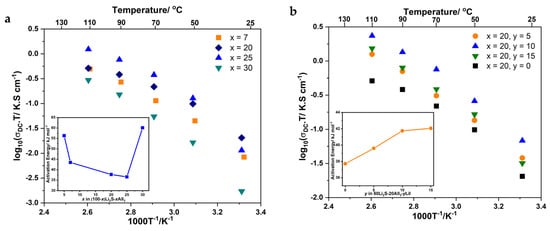
Figure 2.
Ionic conductivity of the prepared samples. (a) Temperature dependence of ionic conductivity of (100 − x)Li2S-xAlI3 samples and the activation energy (small inset); (b) Temperature dependence of ionic conductivity of (80Li2S − 20AlI3)·yLiI (y = 0, 5, 10, 15) samples and the activation energy (small inset).
Figure 3a shows the time dependence of DC current when a voltage of 0.2, 0.5, and 0.7 V (DC) was applied to sample (80Li2S − 20AlI3)·10LiI using a blocking electrode. The polarization was initially observed, and then the current became nearly constant. The electronic conductivity was about 1.1 × 10−8 Scm−1. Since (80Li2S − 20AlI3)·10LiI reacts with Li metal, a thin layer of Li6PS5Cl was employed to prevent (80Li2S − 20AlI3)·10LiI from direct contact with Li metal. A constant current was obtained when 0.5 V (DC) was applied to the cell LiǀLi6PS5Clǀ(80Li2S − 20AlI3)·10LiIǀ Li6PS5ClǀLi (Figure 3b). The constant current obtained using the non-blocking electrode was about 104 times higher than that obtained using the blocking electrode; thus, (80Li2S − 20AlI3)·10LiI is considered a pure Li-ion conductor with a Li-ion transport number higher than 0.999. In addition, the ionic conductivity calculated from the current values was about 2.1 × 10−4 Scm−1 at 25 °C, which resembled the value 2.3 × 10−4 Scm−1 obtained from AC impedance spectroscopy.
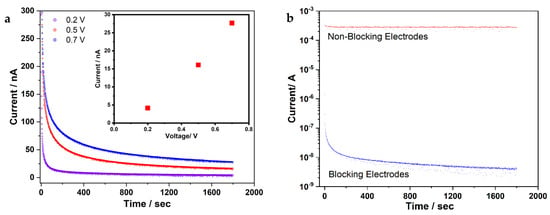
Figure 3.
Conductivity of (80Li2S − 20AlI3)·10LiI. (a) Time dependence of the conductivity at constant applied voltage of 0.2, 0.5, and 0.7 V using blocking electrodes (SUSǀ(80Li2S − 20AlI3)·10LiIǀSUS); the small inset illustrates the values of constant current at each applied voltage. (b) Time dependence of the conductivity at constant applied voltage of 0.5 V using blocking electrodes (SUSǀ(80Li2S − 20AlI3)·10LiIǀSUS) and non-blocking electrodes LiǀLi6PS5Clǀ(80Li2S − 20AlI3)·10LiIǀLi6PS5ClǀLi.
Figure 4a,b shows the Nyquist plots of 80Li2S − 20AlI3 and (80Li2S − 20AlI3)·10LiI measured at 28–90 °C, respectively. All the plots consist of a semicircle and a low-frequency tail, which is consistent with Li+ blocking at the SUS electrodes, expressing ionic conductive behavior. The diameter of the semicircle gradually decreased with increasing temperature and was almost negligible at 90 °C. The total impedance value of the electrolyte pellet is the value at the intersection point between the semicircle and the x-axis in the intermediate frequency region [30]. The impedance spectra recorded at room temperature of 80Li2S − 20AlI3 and (80Li2S − 20AlI3)·10LiI are plotted in Figure 4c,d, respectively. The equivalence circuit of the impedance spectrum is shown in Figure 4c. The impedance resistance of 80Li2S − 20AlI3 is composed of bulk, interface, and grain boundary resistances (the color-filled regions) [31,32]. The bulk resistance of the SE (Rbulk) is obtained from the intersection between the semicircle and the x-axis in the high-frequency region. The semicircle in the intermediate region is composed of interfacial resistance (RInterfacial) and grain boundary resistance (RGrain boundary). The Rbulk value of 80Li2S − 20AlI3 is close to that of (80Li2S − 20AlI3)·10LiI. While the RInterfacial + RGrain boundary value of (80Li2S − 20AlI3)·10LiI is smaller than that of 80Li2S − 20AlI3. These results indicate that LiI addition effectively reduces the value of RInterfacial + RGrain boundary.
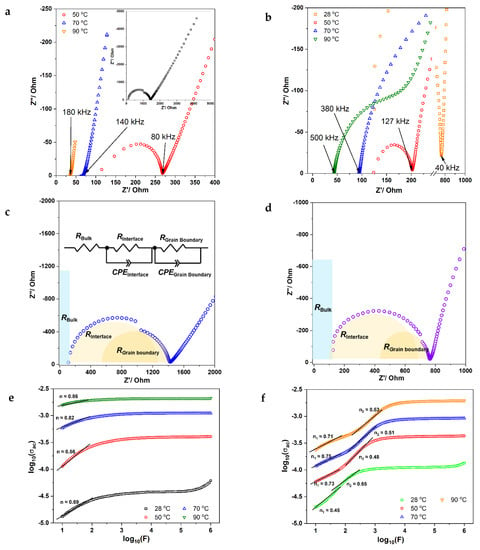
Figure 4.
(a) Nyquist plots of 80Li2S − 20AlI3 measured from 28 to 90 °C (the inset shows the Nyquist plot at 28 °C); (b) Nyquist plots of (80Li2S − 20AlI3)·10LiI measured from 28 to 90 °C; (c,d) the matching impedance figures, equivalent circuit of 80Li2S − 20AlI3 and (80Li2S − 20AlI3)·10LiI measured at 28 °C, respectively; (e) conductivity isotherms (10 Hz to 1 MHz) of 80Li2S − 20AlI3 measured from 28 to 90 °C; (f) conductivity isotherms (10 Hz to 1 MHz) of (80Li2S − 20AlI3)·5LiI measured from 28 to 90 °C.
The conductivity isotherms of 80Li2S − 20AlI3 and (80Li2S − 20AlI3)·10LiI recorded from 28 to 90 °C, the real part σ″ of the complex conductivity plotted against frequency F, are depicted in Figure 4e,f, respectively. The isotherms display a frequency independence plateau in high and intermediate frequency regions, which is the so-called direct current (DC) region [33,34]. This region indicates long-range ion transport. Frequency dependence of conductivity is clearly observed in the low-frequency region, which exhibits the polarization effect. Jonscher’s power law σ″ ∝ ωn was observed in the low-frequency region, where ω is the angular frequency and n represents the interaction between the mobile ion and its surrounding environment [35,36]. Temperature dependence of n is clearly observed in sample 80Li2S − 20AlI3 and the n values are higher than 0.6, indicating the dipole behaviors of charge carriers in this sample [36]. Two distinct slopes appear in the low-frequency region of the isotherms of sample (80Li2S − 20AlI3)·10LiI, with n values close to 0.7 and 0.5. The n values also indicated the dipoles behaviors of charge carriers, but the presence of two slopes suggested the existence of two types of materials in the sample (80Li2S − 20AlI3)·10LiI.
Liǀ(80Li2S − 20AlI3)·10LiIǀLi and LiǀLi6PS5Clǀ(80Li2S − 20AlI3)·10LiIǀLi6PS5ClǀLi symmetric cells were employed to investigate the stability of (80Li2S − 20AlI3)·10LiI at a low voltage region. The small inset in Figure 5a proved that the reaction between (80Li2S − 20AlI3)·10LiI and Li metal is irreversible. However, the LiǀLi6PS5Clǀ(80Li2S − 20AlI3)·10LiIǀLi6PS5ClǀLi symmetric cell exhibited a relatively steady charge–discharge voltage for more than 200 h. These results indicated that (80Li2S − 20AlI3)·10LiI irreversibly reacts with Li metal, but it is quite stable in the low-voltage region. All-solid-state cells, which employed (80Li2S − 20AlI3)·10LiI, as solid electrolyte in the positive electrode, were fabricated to study their stability at high voltage regions. CuS and Li4.4Si were used as active materials. Figure 5b–e illustrates the electrochemical performances of the prepared cells. The 1st and 10th charge—discharge curves of the cells cycling using CC and CC-CV modes are depicted in Figure 5b,d, respectively. Two distinct plateaus are observed in the discharge curves, which arise from the following reactions [37]:
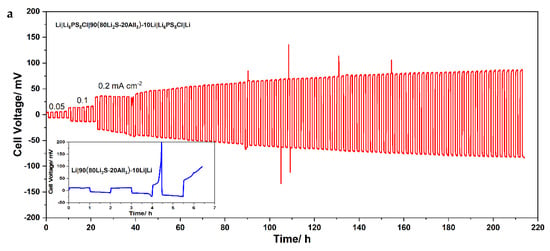
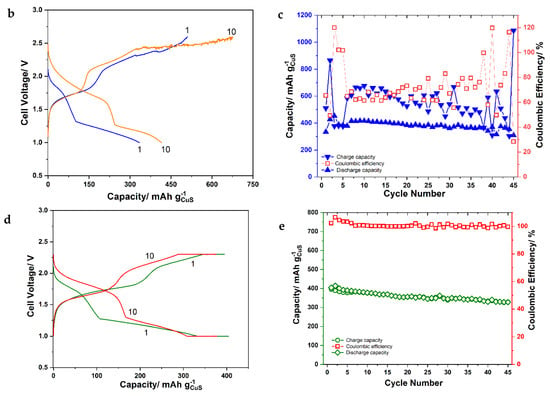
Figure 5.
(a) Cyclability of the symmetric LiǀLi6PS5Clǀ(80Li2S − 20AlI3)·10LiIǀLi6PS5ClǀLi and Liǀ(80Li2S − 20AlI3)·10LiIǀLi (small inset); (b) 1st and 10th charge–discharge curves of the solid-state cell cycled using CC mode; (c) cyclic properties of the solid-state cell using CC mode; (d) 1st and 10th charge–discharge curves of the solid-state cell cycled using CC-CV mode; (e) cyclic properties of the solid-state cell using CC-CV mode.
- The first plateau: CuS + 1.96Li+ + 1.96e− → Li2S + Cu1.96S.
- The second plateau: Cu1.96S + 2Li+ → Li2S + 1.96Cu.
Accordingly, two distinct plateaus also appeared in the charge curves. The charge curve in Figure 5b was smooth at low voltage and bumpy at voltage higher than 2.3 V, which illustrated the decomposition of (80Li2S − 20AlI3)·10LiI composite solid electrolyte. The discharge and charge capacity were about 400 and 600 mAh g−1CuS, respectively (Figure 5c), resulting in the capacity loss of about 200 mAh g−1CuS and unstable Coulombic efficiency (Figure 5c). Figure 5c indicates that the discharge capacity was stable at about 400 mAh g−1CuS but the charge capacity was unsteady, showing the continuous decomposition of solid electrolyte. The cyclic voltammogram of Li3SI solid electrolyte also indicated the oxidation of S2− at about 2 V, which was one of the reasons for low capacity retention of the all-solid-state cell cycling in the voltage range of 2.0–3.6 V [24]. Thus, (80Li2S − 20AlI3)·10LiI composite solid electrolyte was irreversibly decomposed at voltage higher than 2.3 V. The cell cycling in CC-CV mode (CC: 0.25 mA cm−2, CV: 2.30 V) exhibits smooth charge–discharge curves (Figure 5d), confirming that (80Li2S − 20AlI3)·10LiI was stable in this voltage region. The charge–discharge capacity was stable at about 400 mAh g−1CuS, resulting in a Coulombic efficiency higher than 99.5%.
4. Conclusions
(100 − x)Li2S-xAlI3 and (80Li2S − 20AlI3)·yLiI (y = 0, 5, 10, 15) composite solid electrolytes were successfully prepared by mechanochemical synthesis. XRD results revealed that Li2S and AlI3 formed a solid solution, while LiI crystals remained in sample y = 15. It was also proved that (80Li2S − 20AlI3)·10LiI is a pure Li-ion conductor with the ionic conductivity of about 2.3 × 10−4 Scm−1 at 25 °C, about three times higher than that of the 80Li2S − 20AlI3 sample. The impedance spectroscopy results revealed that LiI addition enhanced the grain boundary and interfacial resistance of the prepared samples. The results from XRD and AC impedance suggested that LiI might be present in the amorphous form in samples y = 5 and 10. The symmetric and all-solid-state cell performance illustrated that (80Li2S − 20AlI3)·10LiI was relatively stable at voltage lower than 2.3 V.
Author Contributions
T.A.T. performed the experiments; N.H.H.P. conceived and designed the experiments, analyzed and interpreted the data, and wrote the paper; L.T.Q.A. and T.V.T. wrote, reviewed, and edited the paper. All authors have read and agreed to the published version of the manuscript.
Funding
This research received no external funding.
Data Availability Statement
Data will be provided upon requested.
Acknowledgments
We acknowledge Ho Chi Minh City University of Technology (HCMUT), VNU-HCM, for supporting this study.
Conflicts of Interest
The authors declare that they have no known competing financial interests or personal relationships that could have influenced the work reported in this paper.
References
- Zhang, Q.; Cao, D.; Ma, Y.; Natan, A.; Aurora, P.; Zhu, H. Sulfide-Based Solid-State Electrolytes: Synthesis, Stability, and Potential for All-Solid-State Batteries. Adv. Mater. 2019, 31, e1901131. [Google Scholar] [CrossRef] [PubMed]
- Bachman, J.C.; Muy, S.; Grimaud, A.; Chang, H.H.; Pour, N.; Lux, S.F.; Paschos, O.; Maglia, F.; Lupart, S.; Lamp, P.; et al. Inorganic Solid-State Electrolytes for Lithium Batteries: Mechanisms and Properties Governing Ion Conduction. Chem. Rev. 2016, 116, 140–162. [Google Scholar] [CrossRef] [PubMed]
- Chen, S.; Xie, D.; Liu, G.; Mwizerwa, J.P.; Zhang, Q.; Zhao, Y.; Xu, X.; Yao, X. Sulfide solid electrolytes for all-solid-state lithium batteries: Structure, conductivity, stability and application. Energy Storage Mater. 2018, 14, 58–74. [Google Scholar] [CrossRef]
- Seino, Y.; Ota, T.; Takada, K.; Hayashi, A.; Tatsumisago, M. A sulphide lithium super ion conductor is superior to liquid ion conductors for use in rechargeable batteries. Energy Environ. Sci. 2014, 7, 627–631. [Google Scholar] [CrossRef]
- Kamaya, N.; Homma, K.; Yamakawa, Y.; Hirayama, M.; Kanno, R.; Yonemura, M.; Kamiyama, T.; Kato, Y.; Hama, S.; Kawamoto, K.; et al. A lithium superionic conductor. Nat. Mater. 2011, 10, 682–686. [Google Scholar] [CrossRef]
- Adeli, P.; Bazak, J.D.; Park, K.H.; Kochetkov, I.; Huq, A.; Goward, G.R.; Nazar, L.F. Boosting Solid-State Diffusivity and Conductivity in Lithium Superionic Argyrodites by Halide Substitution. Angew. Chem. 2019, 58, 8681–8686. [Google Scholar] [CrossRef]
- Feng, X.; Chien, P.-H.; Patel, S.; Zheng, J.; Immediato-Scuotto, M.; Xin, Y.; Hung, I.; Gan, Z.; Hu, Y.-Y. Synthesis and characterizations of highly conductive and stable electrolyte Li10P3S12I. Energy Storage Mater. 2019, 22, 397–401. [Google Scholar] [CrossRef]
- Sakuda, A.; Yamauchi, A.; Yubuchi, S.; Kitamura, N.; Idemoto, Y.; Hayashi, A.; Tatsumisago, M. Mechanochemically Prepared Li2S-P2S5-LiBH4 Solid Electrolytes with an Argyrodite Structure. ACS Omega 2018, 3, 5453–5458. [Google Scholar] [CrossRef]
- Liu, Z.; Fu, W.; Payzant, E.A.; Yu, X.; Wu, Z.; Dudney, N.J.; Kiggans, J.; Hong, K.; Rondinone, A.J.; Liang, C. Anomalous high ionic conductivity of nanoporous beta-Li3PS4. J. Am. Chem. Soc. 2013, 135, 975–978. [Google Scholar] [CrossRef]
- Hayashi, A.; Fukuda, T.; Hama, S.; Yamashita, H.; Morimoto, H.; Minami, T.; Tatsumisago, M. Lithium ion conducting glasses and glass-ceramics in the system Li2S-MxSy (M = Al, Si and P) prepared by mechanical milling. J. Ceram. Soc. Jpn. 2004, 112, S695–S699. [Google Scholar]
- Kondo, S.; Takada, K.; Yamamura, Y. New lithium ion conductors based on Li2S-SiS2 system. Solid State Ionics 1992, 53–56, 1183–1186. [Google Scholar] [CrossRef]
- Takada, K.; Aotani, N.; Kondo, S. Electrochemical behaviors of Li+ ion conductor, Li3PO4-Li2S-SiS2. J. Power Sources 1993, 43–44, 135–141. [Google Scholar] [CrossRef]
- Hayashi, A.; Fukuda, T.; Morimoto, H.; Minami, T.; Tatsumisago, M. Amorphous solid electrolytes in the system Li2S-Al2S3-SiS2 prepared by mechanical milling. J. Mater. Sci. 2004, 39, 5125–5127. [Google Scholar] [CrossRef]
- Kinoshita, S.; Okuda, K.; Machida, N.; Naito, M.; Sigematsu, T. All-solid-state lithium battery with sulfur/carbon composites as positive electrode materials. Solid State Ion. 2014, 256, 97–102. [Google Scholar] [CrossRef]
- Seh, Z.W.; Wang, H.; Hsu, P.-C.; Zhang, Q.; Li, W.; Zheng, G.; Yao, H.; Cui, Y. Facile synthesis of Li2S–polypyrrole composite structures for high-performance Li2S cathodes. Energy Environ. Sci. 2014, 7, 672. [Google Scholar] [CrossRef]
- Wu, F.; Magasinski, A.; Yushin, G. Nanoporous Li2S and MWCNT-linked Li2S powder cathodes for lithium-sulfur and lithium-ion battery chemistries. J. Mater. Chem. A 2014, 2, 6064–6070. [Google Scholar] [CrossRef]
- Han, F.; Yue, J.; Fan, X.; Gao, T.; Luo, C.; Ma, Z.; Suo, L.; Wang, C. High-Performance All-Solid-State Lithium-Sulfur Battery Enabled by a Mixed-Conductive Li2S Nanocomposite. Nano Lett. 2016, 16, 4521–4527. [Google Scholar] [CrossRef]
- Lin, Z.; Liu, Z.; Dudney, N.J.; Liang, C. Lithium Superionic Sulfide Cathode for All-Solid Lithium-Sulfur Batteries. ACS Nano 2013, 7, 2829–2833. [Google Scholar] [CrossRef]
- Jiang, H.; Han, Y.; Wang, H.; Zhu, Y.; Guo, Q.; Jiang, H.; Zheng, C.; Xie, K. Li2S-Li3PS4 (LPS) Composite Synthesized by Liquid-Phase Shaking for All-Solid-State Lithium-Sulfur Batteries with High Performance. Energy Technol. 2020, 8, 2000023. [Google Scholar] [CrossRef]
- Hakari, T.; Hayashi, A.; Tatsumisago, M. Li2S-Based Solid Solutions as Positive Electrodes with Full Utilization and Superlong Cycle Life in All-Solid-State Li/S Batteries. Adv. Sustain. Syst. 2017, 1, 1700017. [Google Scholar] [CrossRef]
- Phuc, N.H.H.; Takaki, M.; Kazuhiro, H.; Hiroyuki, M.; Atsunori, M. Dual effect of MgS addition on Li2S ionic conductivity and all-solid-state Li–S cell performance. SN Appl. Sci. 2020, 2, 1803. [Google Scholar] [CrossRef]
- Phuc, N.H.H.; Takaki, M.; Hiroyuki, M.; Atsunori, M. Preparation of Li2-3xAlxS for All-Solid-State Li-S Battery. Front. Energy Res. 2021, 8, 606023. [Google Scholar] [CrossRef]
- Gamo, H.; Maeda, T.; Hikima, K.; Deguchi, M.; Fujita, Y.; Kawasaki, Y.; Sakuda, A.; Muto, H.; Phuc, N.H.H.; Hayashi, A.; et al. Synthesis of an AlI3-doped Li2S positive electrode with superior performance in all-solid-state batteries. Mater. Adv. 2022, 3, 2488–2494. [Google Scholar] [CrossRef]
- Rajagopal, R.; Park, M.-H.; Subramanian, Y.; Jung, Y.J.; Ryu, K.-S. Synthesis and electrochemical performance of antiperovskite-like Li3SI solid electrolyte. J. Electroanal. Chem. 2021, 895, 115477. [Google Scholar] [CrossRef]
- Tamori, R.; Machida, N.; Shigematsu, T. Preparation of Li4.4Si Alloy by Use of Mechanical Milling Methods and Its Properties as Negative Electrodes in Lithium Cells. J. Jpn. Soc. Powder Powder Metall. 2001, 48, 267–273. [Google Scholar] [CrossRef]
- Phuc, N.H.H.; Gamo, H.; Hikima, K.; Muto, H.; Matsuda, A. Novel (100-x-y)Li3PS4-xLiBF4-yLiCl amorphous solid electrolytes for all-solid-state Li ion battery. J. Non-Cryst. Solids 2022, 593, 121768. [Google Scholar] [CrossRef]
- Phuc, N.H.H.; Maeda, T.; Yamamoto, T.; Muto, H.; Matsuda, A. Preparation of Li3PS4–Li3PO4 Solid Electrolytes by Liquid-Phase Shaking for All-Solid-State Batteries. Electron. Mater. 2021, 2, 39–48. [Google Scholar] [CrossRef]
- Suyama, M.; Kato, A.; Sakuda, A.; Hayashi, A.; Tatsumisago, M. Lithium dissolution/deposition behavior with Li3PS4-LiI electrolyte for all-solid-state batteries operating at high temperatures. Electrochim. Acta 2018, 286, 158–162. [Google Scholar] [CrossRef]
- Rangasamy, E.; Liu, Z.; Gobet, M.; Pilar, K.; Sahu, G.; Zhou, W.; Wu, H.; Greenbaum, S.; Liang, C. An iodide-based Li7P2S8I superionic conductor. J. Am. Chem. Soc. 2015, 137, 1384–1387. [Google Scholar] [CrossRef]
- Suzuki, K.; Sakuma, M.; Hori, S.; Nakazawa, T.; Nagao, M.; Yonemura, M.; Hirayama, M.; Kanno, R. Synthesis, structure, and electrochemical properties of crystalline Li–P–S–O solid electrolytes: Novel lithium-conducting oxysulfides of Li10GeP2S12 family. Solid State Ion. 2016, 288, 229–234. [Google Scholar] [CrossRef]
- Xu, R.C.; Xia, X.H.; Yao, Z.J.; Wang, X.L.; Gu, C.D.; Tu, J.P. Preparation of Li7P3S11 glass-ceramic electrolyte by dissolution-evaporation method for all-solid-state lithium ion batteries. Electrochim. Acta 2016, 219, 235–240. [Google Scholar] [CrossRef]
- Wei, J.; Kim, H.; Lee, D.-C.; Hu, R.; Wu, F.; Zhao, H.; Alamgir, F.M.; Yushin, G. Influence of annealing on ionic transfer and storage stability of Li2S–P2S5 solid electrolyte. J. Power Sources 2015, 294, 494–500. [Google Scholar] [CrossRef]
- Gombotz, M.; Wilkening, H.M.R. Fast Li Ion Dynamics in the Mechanosynthesized Nanostructured Form of the Solid Electrolyte Li3YBr6. ACS Sustain. Chem. Eng. 2020, 9, 743–755. [Google Scholar] [CrossRef]
- Hanghofer, I.; Brinek, M.; Eisbacher, S.L.; Bitschnau, B.; Volck, M.; Hennige, V.; Hanzu, I.; Rettenwander, D.; Wilkening, H.M.R. Substitutional disorder: Structure and ion dynamics of the argyrodites Li6PS5Cl, Li6PS5Br and Li6PS5I. Phys. Chem. Chem. Phys. PCCP 2019, 21, 8489–8507. [Google Scholar] [CrossRef]
- Jonscher, A.K. The ‘universal’ dielectric respond. Nature 1977, 267, 673–679. [Google Scholar] [CrossRef]
- Ngai, K.L.; Jonscher, A.K.; White, C.T. On the origin of the universal dielectric respond in condensed matter. Nature 1979, 277, 185–189. [Google Scholar] [CrossRef]
- Hayashi, A.; Ohtomo, T.; Mizuno, F.; Tadanaga, K.; Tatsumisago, M. All-solid-state Li S batteries with highly conductive glass–ceramic electrolytes. Electrochem. Commun. 2003, 5, 701–705. [Google Scholar] [CrossRef]
Disclaimer/Publisher’s Note: The statements, opinions and data contained in all publications are solely those of the individual author(s) and contributor(s) and not of MDPI and/or the editor(s). MDPI and/or the editor(s) disclaim responsibility for any injury to people or property resulting from any ideas, methods, instructions or products referred to in the content. |
© 2023 by the authors. Licensee MDPI, Basel, Switzerland. This article is an open access article distributed under the terms and conditions of the Creative Commons Attribution (CC BY) license (https://creativecommons.org/licenses/by/4.0/).